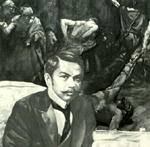


Born in Badoc, Ilocos Norte on October 23,
1857 with Joaquin Luna and Laureana Novicio as his parents, Juan Luna is the creator of the world-famous painting
"Spolarium."

He studied at the Ateneo de Manila,
enlisted for the maritime services but had to quit because he pursued his studies in painting. In 1877, he sailed for
Barcelona and made his debut as a professional painter in 1880 with "The Death of Cleopatra," which won second prize in
the Madrid Exposition and was purchased by the Spanish government. It is now on permanent exhibit in the Museo Nacional
de Pinturas, Salon de Pinturas Modernas in Madrid..
His "Spolarium" garnered him a gold medal
in the Exposicion Nacional de Bellas Artes in Madrid in 1884. It fetched 20,000 pesetas in 1886 when sold to the
Diputacion Provincial de Barcelona.
In October 1884, he transferred his studios
to Paris and on 1896 married Paz Pardo de Tavera. When he went back to Manila after 17 years, he was imprisoned being a suspect
during the outbreak of the Revolution. He was pardoned by the Queen Regent on May 27, 1897.
In 1898, he represented the country in a peace
discussion. He died on December 7, 1899 in Hongkong of heart attack.
